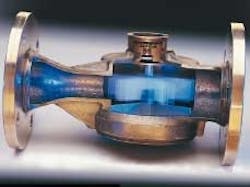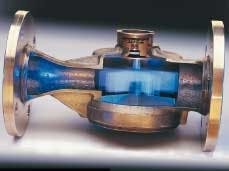New AWWA Meter Standard in Final Development
By DUANE CHISM
The American Water Works Association's Meter Standards Committee has formed a Single-jet Sub Committee to develop a new AWWA standard for single-jet water meters. After two committee votes and numerous meetings, the final draft is expected to be released in the coming months.
Single-jet water meters were designed in the mid 1970's to offset the limitations of existing meter technologies. They are accurate over a wider range of flows and have reduced maintenance requirements when compared with some other technologies.
A single-jet is a velocity type meter that incorporates a "single" tangential jet which flows across a paddle wheel or impeller. The impeller is offset from the water flowing through the jet such that the water travels perpendicular to the rotational axis of the impeller. This is the characteristic that separates the single-jet from Class I or Class II turbines where water flows along the rotational axis as opposed to perpendicular.
From an engineering standpoint, the effects of this operation are significant. By operating perpendicular to the impeller, water flow through the single-jet meter exerts very little if any force (both thrust and pivot) on the bearings carrying the impeller. Said another way; the maximum force on the bearing is the weight of the impeller, which has a specific gravity of just over one.
In addition to the tangential jet, single-jet meters incorporate a "lifting" function whereby the impeller actually floats during operation. With the impeller afloat, the pivot bearing at the bottom of the impeller is relieved of wear. This allows for a sensitive bearing and thus excellent low flow measurement characteristics. The combination of the single tangential jet and the floating impeller allows for precise water measurement without periodic maintenance.
On average, the normal period of operation before servicing is at least 12-15 years. In most cases, single-jet meters tested to a higher degree of accuracy after 10 years of service than compound, turbine, and displacement meters tested when new.
Single-jet meters have long been recognized in the U.K as precise water meters and meet or exceed the International Standard Organization's Class C, highest accuracy requirement for commercial meters and Class D, highest requirement for residential meters.
Single-Jet Vs Displacement
Single-jet meters typically operate at 10 times the low flow accuracy of like size displacement meters. For example, a Class C, 2-inch single-jet meter begins registration at 1/16th gpm and is 100 percent accurate from 1/4-160 gpm. That is compared to the AWWA C700 Characteristics of Displacement Meters where a 2 inch has a normal operating range of 2-160 gpm at 100 percent.
In a recent test at a Southwestern water utility, the average percentage increase of water recorded by single-jet and unrecorded by displacement was over 10 percent. Additional revenue collected from single-jets totaled $8,604 over a period of less than one year.
All meters were tested for accuracy prior to installation to insure no over registration could occur, therefore the additional revenue can be directly linked to the single-jet meter's accuracy at low flow.
Single-Jet Vs Turbine
Similar to the above example, single-jet meters are more accurate at low flows than similar size turbine meters. For example, a Class C, 3-inch single-jet meter has an accuracy range of 1/2-520 gpm at 100 percent. In comparison, a 3 inch turbine that meets AWWA C-701 standards will have a normal test flow range of 8-350 gpm. Most 3 inch turbines, however, will begin accurate measurement at roughly 5 gpm.
In testing conducted at a Midwestern utility over a billing cycle of roughly one-year, single-jet meters recorded 27 percent more water than turbine meters. It is important to note that in these tests each location contained a single-jet and turbine meter set in tandem so that the same water flow passed through each meter, ensuring a valid "apples to apples" comparison. The financial analysis of the test showed a revenue increase due to the low flow accuracy of the single-jet meter of $13,853. Again, all meters were tested for accuracy prior to installation.
"We were curious enough to run a pilot program for about a year with fifteen 2 inch meters to see if Metron-Farnier's charts and claims were correct," said Gregory R. Disher, Administrator, Stevens Point Water Department, Wisconsin. "Average increase in revenue was approximately 17 percent and because of this and the meter warranty, we decided to exchange all of the commercial meters in our system."
Single-Jet Vs Compound
Compound meters are the only meter type currently available that can match single-jet meters for low flow accuracy. However, compounds contain a combination of a displacement meter and a turbine meter with a valve to direct water flow between each. This is a complicated design using several moving parts and points of wear. As such, compounds can be maintenance intensive.
A series of tests were conducted with a compound and single-jet meter in tandem on each sight. After a test period of just over one year, single-jet meters showed 28 percent greater water registration than the compounds. Of the six test sites sampled, three showed no registration difference between the compound and single-jet. The other three, however, showed differences ranging from 8 percent to 97 percent. Unlike the preceding tests this was not due to low flow under-registration but rather the inability of the compound meters to remain accurate over time.
Low Flow Usage
Although difficult to quantify, a large amount of commercial water usage occurs at low flow rates. In a recent study it was common to see 20-30 percent of all commercial water usage in 3 inch-6 inch meter sites to occur below 10 gpm. At sites with 1 1/2 inch-2 inch meters, 10-20 percent of flow was below 2 gpm.
In a study examining water usage in an apartment complex, a data log showed flows below 10 gpm to occur more than 50 percent of the time. In a sample from a typical hotel, usage patterns showed approximately 40 percent of water usage to occur below 10 gpm.
Historically, traditional commercial meters have proven to be the least accurate due to the tremendous flow they must register compared to residential meters. Because of this, the AWWA recommends that larger, commercial meters be tested and repaired frequently to ensure accuracy.
The AWWA states, "Experience shows, the greater concern of a water utility should be the inequities and revenue loss that result from underregistration of meters."
On average, a typical water utility will generate 50 percent of all meter revenues from 2-5 percent of its total metered services. This 2-5 percent typically is made up of commercial meters in service connections of 1 1/2 inch-8 inch.
With these few meters making up such a large portion of overall utility revenue, it is imperative that they operate as accurately as possible at all flow rates. Unfortunately, many water utilities do not have the staffing or maintenance budgets required to maintain commercial meter accuracy. Additionally, if all current types of meters (compounds, turbines, and displacements) were operating at new meter accuracy, the limitations of each design preclude the utility from maximizing revenue. Particularly on 1 1/2 inch and 2 inch services, displacement meters simply do not have the range necessary to account for the low flow usage.
Conclusion
Commercial water meters are the most critical meters in any water system. On average nearly 18 percent of water produced is unbilled. A major contributor to unbilled water is inaccurate and/or mistyped meters. In analyzing a metering system, it is important to recognize that while large meters account for only a small percentage of the total population of meters, they represent, on average, nearly 45 percent of a utility's total revenue.
About the Author:
Duane Chism is the Director of Water for the City of Santa Maria, CA.

